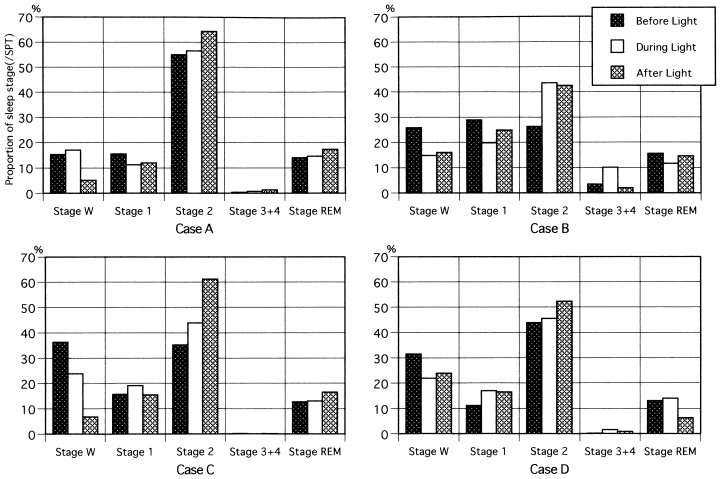Effects of bright light at lunchtime on sleep in patients in a geriatric hospital II
Abstract
Inpatients with sleep disturbances in a geriatric hospital received 1 h of exposure to approximately 8000 lx bright light per day for 3 weeks. Polysomnogram was recorded for four female patients. Two (aged 68 and 87 years) were non-demented patients with weak cataracts and the other two (aged 92 and 93 years) were demented patients with severe cataracts. Electroencephalogram results showed that light exposure decreased the proportion of Stage W, while increased the proportion of Stage 2, and these effects continued for at least 3 weeks after the cessation of light exposure. These results suggest that exposure to bright light is effective in improving the disturbed sleep of patients.
INTRODUCTION
Many inpatients in geriatric hospitals suffer from multiple diseases. They also show sleep disturbances, which may reduce their ability to engage in daytime activities and socially interact with others. We reported previously that sleep quality in elderly people was improved following exposure to bright light in the morning.1,2 A similar effect of light exposure was also expected in patients with sleep disturbance. Such people have less chance to be exposed to light than healthy elderly people. Therefore, we investigated the effects of exposure to bright light in patients.
SUBJECTS AND METHODS
Polysomnogram was recorded for four female patients. Two patients (case A, aged 68 years; case B, aged 87 years) were non-demented. The other two patients were demented (case C, aged 92 years; case D, aged 93 years). Their types of sleep disturbance were as follows: difficulty in initiating sleep (cases B, C), difficulty in maintaining night sleep (cases A, B, C, D), early morning awakening (cases A), irregular sleep–wake rhythm (cases D) and frequent daytime napping (cases C, D). Ophthalmological examinations before light exposure indicated mild cataracts in cases A and B, and severe cataracts in cases C and D. No change to medication was permitted during this program.
After obtaining informed consent, light exposure was performed for 3 weeks in a light therapy room where the luminaries radiating the high luminous flux were installed at the ceiling–wall junction. Exposure time was 1 h at lunchtime (11:30–12:30 h) under the support of the nursing staff of each ward. Patients were not expected to either sit before a desktop lighting device or face direct exposure. The average illuminance at the table was approximately 8000 lx. For two 3-week periods, one before light exposure (BL) and one after light exposure (AL), patients took lunch as during the 3 weeks of light exposure (DL), except that the illuminance was decreased to approximately 1000 lx. Polysomnogram was recorded on the last two consecutive nights of each period. Sleep stages were scored according to Rechtschaffen and Kales criteria.
RESULTS
Figure 1 represents the sleep parameters of the four patients for each period. Compared to BL, an increase in the proportion of Stage 2 was recognized in all cases at DL and AL. Lower percentages of stage W were recognized in cases B, C and D at DL and in all cases at AL. However, characteristic changes were not observed in the proportions of Stage 1, Stages 3 + 4 and Stage REM.

Sleep parameters of four cases in the periods before, during and after bright light exposure.
DISCUSSION
A previous study suggested that morning light therapy for 1 month is effective in reducing daytime and increasing night-time sleep in patients with dementia.3 The present study suggested that lunchtime bright light exposure also improved the quality of sleep in elderly patients both with and without dementia. This effect continued after the cessation of the light exposure. It was assumed that the light exposure improves the quality of night-time sleep and thus contributes to an increase in daytime social contact with staff. Such an effect may result in an improvement in night sleep after the cessation of light exposure. Campbell et al. reported that subjects with Alzheimer-type senile dementia were significantly less exposed to bright light than healthy controls.4 Elderly inpatients spend their days indoors and so are less exposed to bright light than healthy elderly people. Age-related physical changes such as severe cataracts may disturb the input of sufficient light, so artificial light exposure may be useful in correcting sleep disturbances in elderly inpatients.
ACKNOWLEDGMENTS
This study would not have been possible without the help and cooperation of the doctors and nursing staff of Hokujukai Hospital (Sapporo, Japan), and without the help of Kazuyoshi Watanabe. The present study was supported in part by a Grant-in-Aid for Scientific Research (C).




